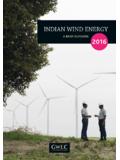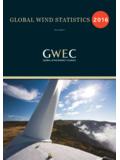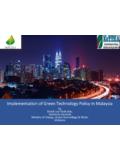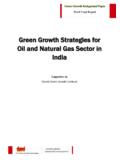Transcription of GLOBAL WIND REPORT - gwec.net
1 THE EUROPEAN UNIONGLOBAL WIND REPORT ANNUAL MARKET UPDATE 2013 GWEC opening up the frontiersfollow us onNavigating the GLOBAL wind power market Photo by Will HermanThe GLOBAL Wind energy Council is the international trade association for the wind power industry communicating the benefits of wind power to national governments, policy makers and international institutions. GWEC provides authoritative research and analysis on the wind power industry in more than 80 countries around the next publications to watch for include:Our mission is to ensure that wind power establishes itself as the answer to today's energy challenges, providing substantial environmental and economic benefits. GWEC represents the industry with or at the UNFCCC, the IEA, international financial institutions, the IPCC and Wind energy Outlook October 2014 GWEC China Wind Development REPORT 2014(English/Chinese) Q4 2014 GLOBAL Statistics February 1 11:513 GWEC GLOBAL Wind 2013 REPORT Foreword 4 Fresh wind for the next big step 5 Redefining the cost debate the Concept of Society s Cost of Electricity 6A Renewable energy future 10 The GLOBAL Status of Wind Power in 2013 16 Market Forecast for 2014 2018 26 Australia
2 32 Belgium 34 Brazil 36 Canada 38 Central and South America & The Caribbean 40PR China 42 Denmark 46 The European Union 48 France 50 Germany 52 GLOBAL offshore 54 India 58 Japan 60 Mexico
3 62 Poland 64 South Africa 66 Sweden 68 Turkey 70 Ukraine 72 United Kingdom 74 United States 76 About GWEC 78 TABLE OF CONTENTS4 GWEC GLOBAL Wind 2013 REPORT FOREWORDFor the first time in more than 20 years, the annual GLOBAL market for wind energy shrank in 2013 We knew that this was likely to be the case when we did our forecast for 2013 one year ago, but we didn t expect the drop in the United States to be as dramatic as it was going from 13 GW in 2012 to just 1 GW in 2013 China once again emerged as the GLOBAL leader, installing 16 GW, and European numbers were steady, resulting in a GLOBAL market of just over 35 GW, and cumulative market growth of 12 5% As has been the case for three of the past four years.
4 The majority of installations were outside the OECD, and this is a trend which will continue to intensify with the emergence of significant markets in Latin America and Africa along with those in Asia which currently drive GLOBAL growth Ironically, partly because of the precipitous drop in the US in 2013, 2014 promises to be a record year The US had an all-time high of more than 12,000 MW under construction in December of 2013, and the nature of last year s PTC extension means that not only 2014 but 2015 will be solid and productive years for US installations as a result But what comes next? There are proposals before Congress now which would end the destructive boom-bust cycle in the US - let s hope they succeed China s market continues its comeback , driven at least in part by public anger at the choking smog engulfing China s major cities; and the offshore segment in China is expected to take off in the next year or two Brazil will most likely double its total installed capacity in 2014, and nearly do so again in 2015.
5 And the South African market is finally out of the starting blocks Canada had a record year in 2013 and will likely set a new one in 2014, although the prospects after 2015 are also very uncertain Europe remains mired in a debate about its support for renewable energy after 2020, and policy retrenchments in a number of countries have meant that although Europe s market posted strong numbers in 2013, future growth now hinges on the debate over whether or not to have binding national targets for renewable for the period from 2020 to 2030 Installing just over 12 GW, the market was concentrated in a smaller number of countries, with Germany and the UK comprising just under 50% of the total, reversing the diversification trend of recent years, which is not a good sign The Indian market is likewise in a state of uncertainty, with erratic policymaking from Delhi, although it is hoped that the elections in May will help get that market back on track So, for 2014 and beyond we can look for most of the growth in the GLOBAL market to come from both new and established markets outside the OECD A rising tide floats all ships , in the sense that it s much easier for wind to get strong market share in a dynamic and growing economy with significant demand growth It s much tougher in markets with low or no demand growth, where the competition and mud-slinging from incumbents is fierce In the absence of a GLOBAL price on carbon, or anything close to it, wind energy s other attributes come to the fore Today in many markets its most compelling selling point is cost-competitiveness wind is already competing successfully against heavily subsidized incumbents in a growing number of markets around the world.
6 As the technology and its implementation steadily improve; and job creation remains a priority just about everywhere Furthermore, recent events in the Ukraine and elsewhere also point to wind energy s contribution to energy security This is the ninth annual REPORT on the status of the GLOBAL wind industry by the GLOBAL Wind energy Council It provides a comprehensive overview of the GLOBAL industry at a moment in time; an industry now present in more than 80 countries, 24 of which have more than 1,000 MW installed The information contained in the REPORT market data, profiles and analysis have been collected primarily through GWEC s member associations around the world, as well as from governments and independent analysts We thank all our contributors and look forward to continuing our close cooperation in the future April 2014 Steve SawyerSecretary GeneralGlobal Wind energy CouncilKlaus RaveChairmanGlobal Wind energy Council5 GWEC GLOBAL Wind 2013 REPORT The worldwide demand for energy is steadily growing At the same time, this trend is being accompanied by rising greenhouse gas emissions We urgently need to correct this current course Our job is to find the right solutions for meeting tomorrow s energy needs.
7 And to implement a sustainable energy mix Wind power offers great potential for tackling this enormous challenge Many countries have already begun to restructure their energy systems in the direction of renewable sources Yet the euphoria of the pioneering era has since faded The GLOBAL financial and economic crisis has unsettled governments and economies alike, and in many countries discussions regarding the conversion of energy systems now center only on short-term costs As a result, we are increasingly losing sight of the long-term benefits offered to economies and societies by the development of renewable energy Raising awareness of the benefitsBy our calculations, by 2035, renewables will be generating more than 25% of world s electricity, with a quarter of this coming from wind, being the second largest renewable energy source after hydro power according to the International energy Agency (IEA) This will lead to a substantial reduction in CO2 emissions and create jobs for hundreds of thousands of people In addition, modern infrastructure will be created, especially in remote areas, providing job opportunities for young people But wind energy also offers major advantages for geopolitical reasons.
8 Wind is widely available throughout the world and can help reduce energy and fuel import dependency Since it entails no fuel price risks or constraints, it also improves the security of supply, thus stabilizing the cost of power generation over the long term Our industry must drive public awareness of these advantages For a fair cost-benefit calculationElectricity production costs are still measured by the LCOE (Levelized Cost of energy ) method alone Yet this energy cost parameter takes only part of the overall picture into account In order to get a more realistic cost-benefit calculation, Siemens has developed the Society s Cost of Electricity (SCoE) concept This formula is based on official sources like the IEA and the Organization for Economic Co-operation and Development (OECD) plus third-party studies, e g by Ernst & Young It takes into account the costs of hidden subsidies, grid development costs, social costs, employment effects and geopolitical factors When all these aspects are taken into consideration in the cost calculation, the advantages of wind energy can already be comprehensively quantified today (see article on p 6) It quickly becomes clear.
9 If you look at the overall costs to the economy, then wind power onshore as well as offshore has long been on equal footing with conventional fuels, if not actually superior to them Keep the big picture in mindThe wind industry should not hide from the public debate about the supposed high costs of renewable energy The SCoE calculation clearly demonstrates that there s no way of getting around developing renewable energy based on wind and not only for reasons of environmental policy, but also from an economic perspective FRESH WIND FOR THE NEXT BIG STEPDr. Markus Tacke CEO of the Wind Power Division of Siemens Energy6 GWEC GLOBAL Wind 2013 REPORT EXPERT OPINION: REDEFINING THE COST DEBATE THE CONCEPT OF SOCIETY S COST OF ELECTRICITYO ffshore wind is under some pressure at the moment The apparent cost gap relative to more conventional power (including onshore wind) remains substantial, and we are at least a decade away from wholesale grid parity There is a risk that some countries might say, We like the concept and we want clean, stable energy , but we can t afford offshore wind From society s perspective, the selection of electricity sources should be based on their true costs Unfortunately, standard measures of electricity costs reveal only part of the picture According to Siemens internal forecasts, GLOBAL generation capacity of electricity is expected to nearly double from today s 6,500 GW to 10,500 GW by 2030 And by 2035, renewables will already be generating more than 25% of world s electricity, with a quarter of this coming from wind, being the second largest renewable energy source after hydro power according to the International energy Agency (IEA) Mark







